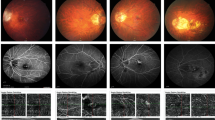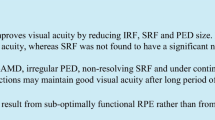Abstract
Purpose
To evaluate the prognosis and response of neovascular age-related macular degeneration (AMD) to anti-vascular endothelial growth factor (VEGF), according to the components of subretinal hyperreflective material (SHRM) classified using optical coherence tomography angiography (OCTA), is the aim of this study.
Methods
We retrospectively studied 39 eyes of 39 consecutive patients with SHRM associated with exudative AMD, who underwent standard examination and multimodal imaging, including fundus photography, optical coherence tomography (OCT), and OCTA. We classified SHRM into type 2 neovascularization (NV), fibrosis, subretinal hyperreflective exudation (SHE), and hemorrhage using OCTA. If compound SHRM was found, components in the foveal center were considered. All patients except one with fibrosis received anti-VEGF treatment for more than 12 months. The best-corrected visual acuity (BCVA) values measured before treatment and at 3, 6, and 12 months after the first injection were compared according to the components of SHRM.
Results
Using OCTA, 11 eyes with type 2 NV showed abnormal blood flow and 1 eye with fibrosis showed strong surface projection. Both SHE and hemorrhage components showed projection artifact with no intrinsic flow. However, OCTA enabled eyes with SHE (17 eyes) to be distinguished from those with hemorrhage (10 eyes) because hemorrhage showed masking of choriocapillaris flow. Eyes with SHE showed a significant improvement in the mean logMAR BCVA as compared with the value at the baseline, which was sustained throughout the 12-month follow-up period (p < 0.05). In eyes with type 2 NV and hemorrhage, no significant difference in the mean BCVA values was observed at any follow-up time-point (all, p > 0.05).
Conclusion
OCTA was useful to noninvasively distinguish SHRM components. It may be important to consider the components of SHRM to predict the visual acuity in patients with AMD.





Similar content being viewed by others
References
Ying GS, Huang J, Maguire MG et al (2013) Baseline predictors for one-year visual outcomes with ranibizumab or bevacizumab for neovascular age-related macular degeneration. Ophthalmology 120:122–129
Ying GS, Kim BJ, Maguire MG et al (2014) Sustained visual acuity loss in the comparison of age-related macular degeneration treatments trials. JAMA ophthalmol 132:915–921
Ying GS, Maguire MG, Daniel E et al (2015) Association of baseline characteristics and early vision response with 2-year vision outcomes in the Comparison of AMD Treatments Trials (CATT). Ophthalmology 122(2523–31):e1
Willoughby AS, Ying GS, Toth CA et al (2015) Subretinal hyperreflective material in the comparison of age-related macular degeneration treatments trials. Ophthalmology 122(1846–53):e5
Ristau T, Keane PA, Walsh AC et al (2014) Relationship between visual acuity and spectral domain optical coherence tomography retinal parameters in neovascular age-related macular degeneration. Ophthalmologica 231:37–44
Keane PA, Liakopoulos S, Chang KT et al (2008) Relationship between optical coherence tomography retinal parameters and visual acuity in neovascular age-related macular degeneration. Ophthalmology 115:2206–2214
Spaide RF, Klancnik JM Jr, Cooney MJ (2015) Retinal vascular layers imaged by fluorescein angiography and optical coherence tomography angiography. JAMA ophthalmol 133:45–50
Dansingani KK, Tan AC, Gilani F et al (2016) Subretinal hyperreflective material imaged with optical coherence tomography angiography. Am J Ophthalmol 169:235–248
Kawashima Y, Hata M, Oishi A et al (2017) Association of vascular versus avascular subretinal hyperreflective material with aflibercept response in age-related macular degeneration. Am J Ophthalmol 181:61–70
Shah VP, Shah SA, Mrejen S, Freund KB (2014) Subretinal hyperreflective exudation associated with neovascular age-related macular degeneration. Retina 34:1281–1288
Miere A, Semoun O, Cohen SY et al (2015) Optical coherence tomography angiography features of subretinal fibrosis in age-related macular degeneration. Retina 35:2275–2284
Ores R, Puche N, Querques G et al (2014) Gray hyper-reflective subretinal exudative lesions in exudative age-related macular degeneration. Am J Ophthalmol 158:354–361
Dansingani KK, Freund KB (2015) Optical coherence tomography angiography reveals mature tangled vascular networks in eyes with neovascular age-related macular degeneration showing resistance to geographic atrophy. Ophthalmic Surg Lasers Imaging Retina 46:907–912
Author information
Authors and Affiliations
Corresponding author
Ethics declarations
Conflict of interest
The authors declare that they have no conflict of interest.
Ethical approval
All procedures performed in studies involving human participants were in accordance with the ethical standards of the institutional and/or national research committee and with the 1964 Helsinki declaration and its later amendments or comparable ethical standards. For retrospective study, formal consent is not required.
Informed consent
Opt-out consent method was chosen, approved by the institutional review board of Yokohama City University because no information identifying individual participants was involved in this article.
Rights and permissions
About this article
Cite this article
Maruyama-Inoue, M., Sato, S., Yamane, S. et al. Variable response of subretinal hyperreflective material to anti-vascular endothelial growth factor classified with optical coherence tomography angiography. Graefes Arch Clin Exp Ophthalmol 256, 2089–2096 (2018). https://doi.org/10.1007/s00417-018-4121-7
Received:
Revised:
Accepted:
Published:
Issue Date:
DOI: https://doi.org/10.1007/s00417-018-4121-7




